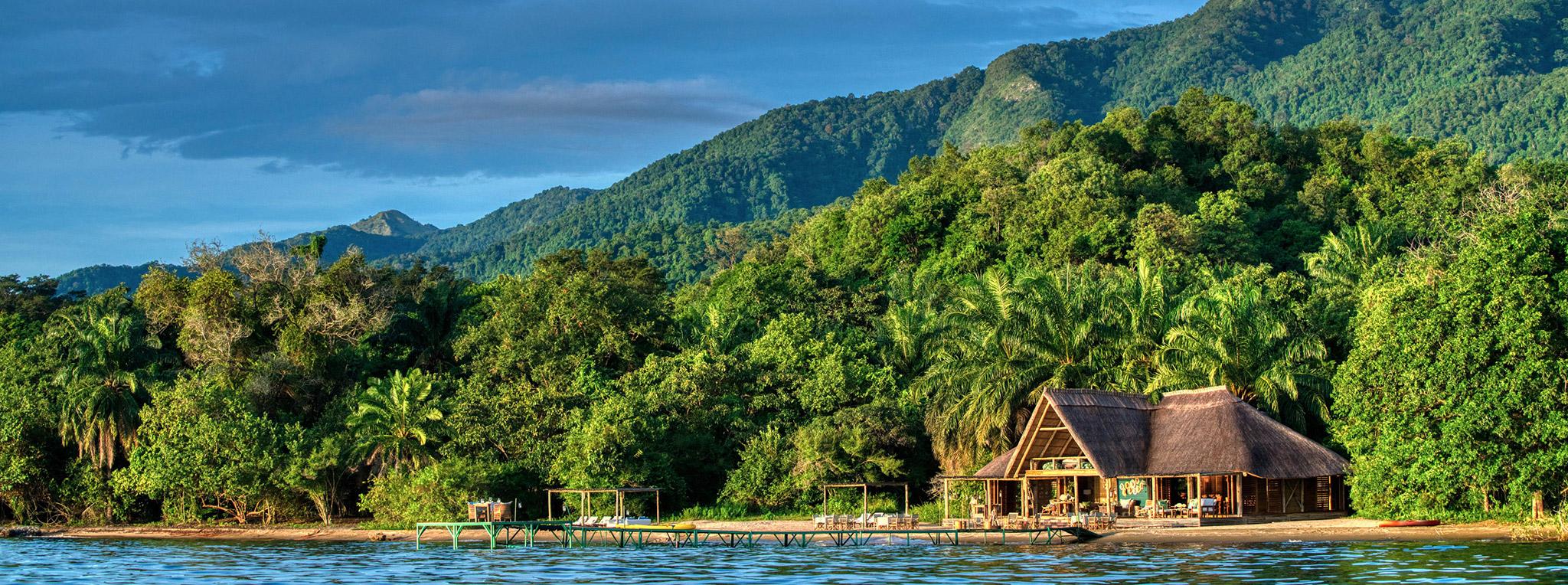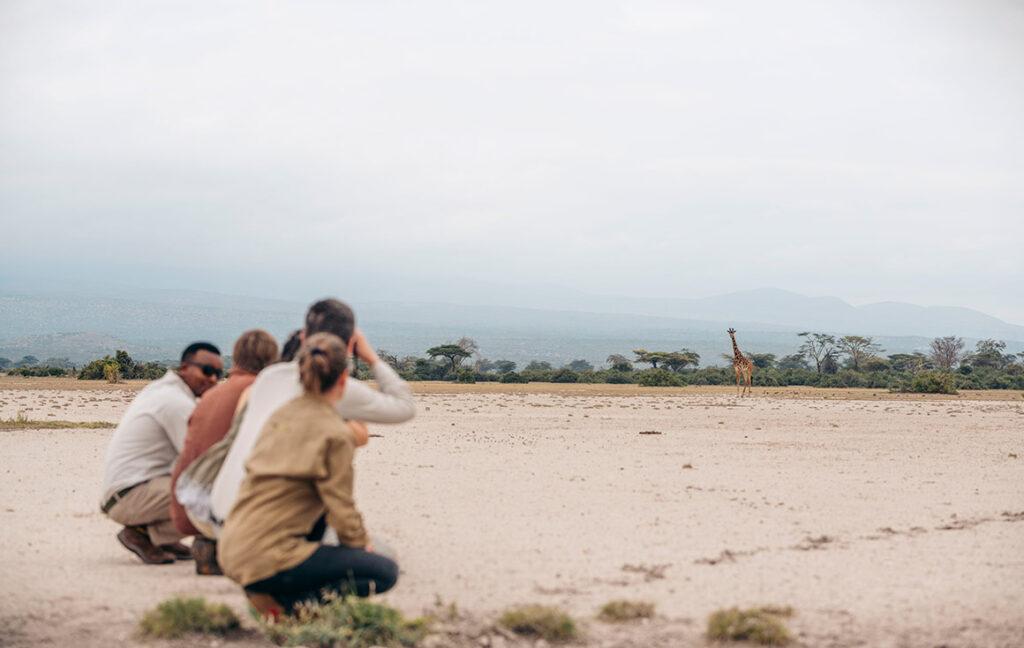Mahale Mountains National Park
1,613km² (623mi²)
1985 (National Park)
All year-round
A remote paradise
Forested peaks rising from the white beached shoreline of Lake Tanganyika make for a magical destination. The park is famous for chimpanzees, but there is much more to discover. Few people visit the park because it is remote and only accessible by light aircraft. Consequently, you will experience the perfect balance between secluded relaxation and adventure. No roads inside the park mean you’ll explore on foot in complete tranquillity, allowing you to see primates, birds, butterflies and spectacular waterfalls. Alternatively, you can snorkel among numerous coloured cichlids, relax on pristine beaches, or watch the sunset on a traditional dhow.

Mahale Mountains National Park: One of Africa’s most unique destinations
Located in remote western Tanzania, Mahale Mountains National Park is one of the most picturesque places to visit in Tanzania. The forested park borders Lake Tanganyika, one of the oldest and deepest lakes in the world, with its white sandy beaches and crystal clear water.
Getting to Mahale Mountains National Park is an adventure, as it is only accessible by air and boat. The park has no roads, only forest paths through the lush vegetation, making this park a hiker’s paradise.
Mahale Mountains National Park is a haven for primates, and chimpanzee trekking is one of the prime reasons to visit. Home to roughly 800 chimpanzees, the Mimikere group is habituated to humans and is easier to spot, thanks to companionship from Japanese researchers for the last five decades.
The park is also absolutely stunning. The forests have beautiful rivers and waterfalls, and along the lake’s shoreline are some of the most unspoilt white sandy beaches imaginable.
Highlights of Mahale Mountains National Park
Mahale Mountain National Park is unique due to its remoteness and the incredible primate trekking, hiking, snorkelling and birdwatching opportunities it offers.
The park is home to nine species of primates, including the Yellow Baboon, Red Colobus, Blue monkeys and the Red-tailed monkeys, and 73 other mammals.
During treks into the forest, chimpanzee sightings can happen between thirty minutes for the first sightings and to up to three hours into a trek. Hikers also have the chance to spot other incredible animals, such as Roan and Sable antelope, mongoose, warthog and sometimes even lion, leopard and crocodiles.
In Lake Tanganyika, hippos are sometimes sighted swimming in the crystal clear waters. Although the amphibian and reptile life at Mahale Mountains National Park has still not been thoroughly researched, at least 20 amphibian and 26 reptile species are believed to reside here.
Home to 355 bird species, a visit to this park is a must for amateur and serious birders. From the white sandy beaches pelicans, storks, Malachite kingfishers, Pied kingfishers and Fish eagles can be seen. Whilst in the forests, it is possible to see the spectacular Livingston’s Turacos, Narina Trogons, Crested Guinea Fowls and Blue Cheeked Bee-eaters.
Snorkelling in the clear shallow waters of Lake Tanganyika allows you to see over 250 endemic fish species.
Chimpanzees
Out of the 14 groups of chimpanzees in the park, the Mimikere group, which is habituated to humans thanks to a long-running Japanese study, is the most likely to be seen.
The Mahale Mountain Range
The park was named after the Mahale Mountain range, which runs parallel to the lake. During a two to three-day trek, you can summit Mount Nkungwe (2,462 m), the highest peak in the park.
A remote fly-in paradise
Discover one of Tanzania’s most beautiful yet secluded destinations. You can expect white unpopulated beaches, amazing snorkelling, unique wildlife, and dhow trips onto the lake to watch the sun go down on this getaway adventure.
WHEN TO GO
Best time to go to the Mahale Mountains National Park
Whilst it is possible to visit the park all year round, the best time to go to Mahale Mountains National Park is the dry season, from June to October. The chance of seeing the chimpanzee is much greater, as they tend to move down to the lower slopes during this season. Due to dry weather and good track conditions, it is also the best time to trek up Mount Nkungwe. Moreover, visibility in Lake Tanganyika can be as good as 20 meters, creating exceptional diving and snorkelling conditions. Finally, low visitor numbers guarantee a secluded experience, even during this peak period.
Dry Season
June to OctoberIdeal for spotting chimpanzees, trekking and snorkelling.
Green Season
March to MayBest for seeing migratory birds and the waterfall roaring.
Why to go
A unique paradise getaway
The Mahale Mountains National Park is arguably Tanzania’s most beautiful and remote destination. It can only be accessed by light aircraft. Once there, you will notice no roads and a handful of footpaths to explore the park. Consequently, this remote park makes you feel that you have it to yourself no matter the season. Moreover, some of the world’s best wildlife viewing, including nine types of primates (including chimpanzees), lions, elephants, buffaloes, Sable antelopes and wild hunting dogs, can be seen here. The birdlife, with 350 recorded species, is spectacular, and it is also a perfect place to relax, thanks to its beautiful beaches. This park has everything and more for those looking for a secluded experience.

Where to stay in the Mahale Mountains National Park
Location
Mahale Mountains National Park is located on the shores of Lake Tanganyika in western Tanzania. As the park is positioned off the beaten track, taking a small aircraft from Arusha or Dar es Salaam directly to the park’s airstrip is the best way to get there. Another option is to board a flight from Dar es Salaam to Kigoma and then take a three to four-hour boat ride from Kigoma to the park’s entrance. Inside the national park, no roads allow you to explore on foot and in peace. Finally, as Mahale Mountains National Park is on the Western Circuit, you can also visit Katavi National Park, another secluded park home to incredible wildlife populations.



Experience Tanzania with us
Speak to one of our travel experts
Let's start planning your trip!
We will get back to you within 2 working days.
 on Tripadvisor
on Tripadvisor











